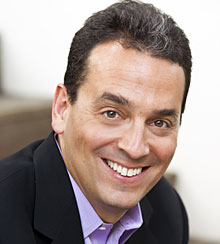Daniel Pink’s New Pitch
In today’s markets, we are all salespeople.
(originally published by Booz & Company)Daniel Pink didn’t plan a career exploring the world of work as much as he gravitated toward it. After studying linguistics at Northwestern University and law at Yale, he became an aide to U.S. Secretary of Labor Robert Reich, and then served as chief speechwriter for Vice President Al Gore. “When I had the opportunity to dole out assignments, I kept the ones about work, labor, business, economics, and technology,” he recalls.
In 1997, disillusioned by the realities of politics and burned out by the workload, Pink quit to write under his own byline. An article published in Fast Company later that year became the kernel for his acclaimed first book, Free Agent Nation: The Future of Working for Yourself (Warner Books, 2002). It plumbed the transition from employee to self-employment by millions of people much like Pink himself, and established a format that Pink has been following ever since: presenting a highly articulate, accessible synthesis of a topic or trend and a practical tool kit for putting it to work at work.
Several more books followed, bringing Pink into the ranks of the world’s leading management thinkers and speakers. His most recent book, To Sell Is Human: The Surprising Truth about Moving Others (Riverhead Books, 2012), explores a topic ripe, perhaps even overripe, for Pinkian synthesis. The very nature of selling has been fundamentally altered by digitization, which continues to render long-accepted sales conventions irrelevant, yet, paradoxically, makes salespeople more important to companies and customers than ever before.
S+B: We used to hear that selling would cease to exist as a function—that salespeople would be disintermediated by the Internet. What really happened?
PINK: Those predictions underestimated how ingenious we would be at creating new products and services, all of which needed to be sold. Yes, we have fewer people selling music, but people are now selling artisanal foods and cloud computing.
The predictions also missed the rise of small entrepreneurship, which means more people are selling their own services. Someone like me isn’t categorized as a salesperson by the Bureau of Labor Statistics, but I spend a huge amount of my time trying to get other people to do things. Moreover, sales is no longer always a discrete function. The software companies Atlassian and Palantir, for example, have no formal sales forces. They say that nobody’s in sales because everyone is in sales. Then there’s non-sales selling. For instance, most of the jobs that have been created in the U.S. in the last 10 years have been in education and healthcare, which are all about selling behavior change.
In 2000, one in nine people in the U.S. workforce was in sales; today, one in nine people is still in sales. And none of the salespeople I interviewed in the course of doing the stories that led up to this book fit the old sales stereotype. They weren’t wearing plaid jackets and patting me on the back all the time, and I didn’t feel the need to cleanse the oil off myself afterward.
S+B: So how would you define selling today?
PINK: I don’t think there’s a catch-all term to describe selling, but for me, moving is the closest word. I’m trying to get you to go from here to there. I can persuade you that the Washington Nationals will win the National League this year, but I’m just changing your mind. Selling is an exchange. If we’re colleagues and I’m trying to get you to join my team, you’re exchanging your time and talent for the opportunity I’m giving you. It’s not denominated in dollars, but I still think that’s sales.
I recognize there are headwinds with sales because of the negative connotations. I’d like to bike into those headwinds and take back the idea of selling, not in a namby-pamby, defensive way, but in a slightly more sharp-elbowed, muscular way. I say in my book that I want people to see the act of selling in a new light. It’s more urgent, more important, and also more beautiful than we realize. It requires some fundamentally human skills, and it has become increasingly conceptual. As the VP of sales of the Italian candy company Perfetti Van Melle told me, “We’ve gone from selling Mentos to selling insights about the confections business.” You can’t get any more conceptual than that.
S+B: You propose changing the ABC sales mantra “Always be closing” to “Attunement, buoyancy, and clarity.”
PINK: These qualities encompass what you should do and how you should be if you want to move other people. For example, attunement is the ability to understand where someone else is coming from; it can also be called perspective taking.
There’s a difference between perspective taking and empathy that I might have conflated in my book A Whole New Mind [originally subtitled Moving from the Information Age to the Conceptual Age (Riverhead, 2005)]. I’ve since come to realize that empathy is related to understanding someone’s emotional state or feelings, whereas perspective taking is much more cognitive and analytical—it’s understanding someone’s interests. I think interests is the key word here.
The facts say that both perspective taking and empathy can enhance your understanding of someone else, but if you have to go with one, go with the analytical. I think the evidence says very clearly that people are able, especially in negotiation and sales situations, to reach a better deal for both sides when they’re focused on interests.
S+B: There’s a great quote in the book from the last Fuller Brush Man about sales being “an ocean of rejection.” How is buoyancy different from the power of positive thinking?
PINK: A lot of the power of positive thinking was not built on any evidence. It was built on beliefs, some of which turned out to be right. But it wasn’t guidance from an empirical perspective. [University of North Carolina professor] Barbara Fredrickson has shown that positivity enhances well-being when it’s in the right balance. She has a three-to-one ratio: Your positive emotions should outnumber your negative emotions by three to one. But if the ratio is above 11 to one, you’re in la-la land.
Studies have also shown that purely positive self-talk—“You can do it,” the Bela Karolyi school—is better than nothing. But it’s less effective than interrogative self-talk. Asking, for example, “Can you do this?” The early proponents of positive thinking would find that abhorrent: You’re questioning your ability? But interrogative self-talk leads to preparation and planning.
Also important is changing the way you explain things. You can ascribe outcomes to internal or external causes. If you lose a sale, it’s probably not entirely your fault. But if you explain it that way, it’s going to be debilitating. If, after a rejection, you say, “Well, this always happens,” that’s just not true. [University of Pennsylvania professor] Martin Seligman’s research has shown that if you adopt an optimistic explanatory style and widen your ability to explain things with accuracy, you’ll be better off.
S+B: You define clarity as “the capacity to help others see their situations in fresh and more revealing ways and to identify problems that they didn’t realize they had.” What role does framing play in that?
PINK: Framing is curation, in a more conceptual sense. You’re looking all over the place and I’m saying, “What’s significant is what’s here.” I’m helping you separate the signal from the noise. If you frame choices in a digestible way, people are more likely to pick something.
If I’m selling you a great used car that has a minor nick, I’m going to be tempted to park the car in such a way that you won’t see the damage. But research by [Tel Aviv University professor] Danit Ein-Gar and [Stanford University professors] Baba Shiv and Zakary Tormala says that I should point it out, because the nick creates the context for everything else. It helps frame the valuation of the car. In some ways, you’re widening the frame when you do this. You’re saying, “Oh, there’s a nick there, but look at everything else. The totality of it is really good.”
Of course, this depends on how essential that nick is. There’s a big difference between a blemish and a scar. If it’s small thing, then widening the frame is actually helpful. If it’s a substantive defect, then you have to either explain that the defect doesn’t matter as much as customers think or lower the price.
S+B: In your final chapter, you propose extending Robert Greenleaf’s concept of servant leadership to sales. Why are service, purpose, and meaning such a pervasive theme throughout your books?
PINK: When you sit down and talk to people about their work, you realize that they’re spending at least half of their waking hours on the job. Their work is a window into who they are. And I think that as human beings, we aspire to do something meaningful. All of us ask ourselves, “OK, why does what I’m doing matter? What is my purpose?”
What’s exciting for companies is that appealing to a sense of purpose and meaning is very effective. [Wharton professor] Adam Grant has done some great research in this area. In a study of people in a call center raising money for a university, he found that employees who spent five minutes before their shift reading letters from people who were on the receiving end of the scholarship money they raised more than doubled their sales results.
S+B: To Sell Is Human is a pretty rare sales book. It doesn’t provide the reader with a sales process.
PINK: I did that consciously, because I don’t think there’s a one-size-fits-all process to selling Winnebagos, to asking somebody out on a date, to getting your kids to clean their room, or to pitching your idea to a book publisher.
I didn’t want to give people a set of custom Legos that builds only one particular castle, even if that’s an awesome way to build that particular castle. I’d rather give people a rich set of basic building blocks, which they can fashion into a process of their own and constantly evaluate. Sales processes tend to be very algorithmic. And when people get wedded to a process or to an algorithm, they miss all kinds of other clues and opportunities that could be really valuable.![]()
Reprint No. 00204




